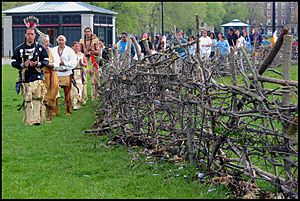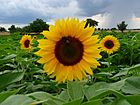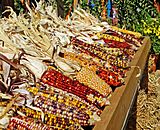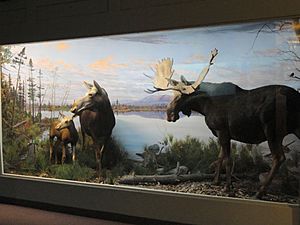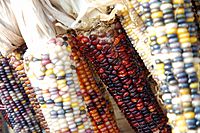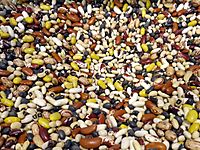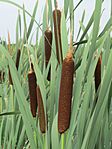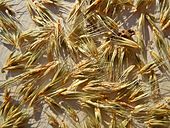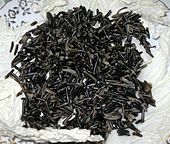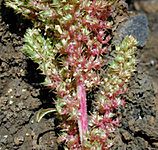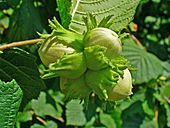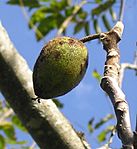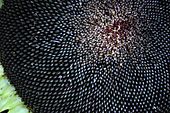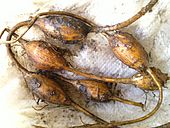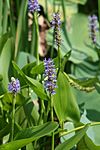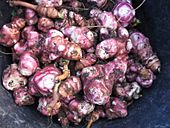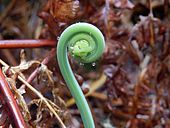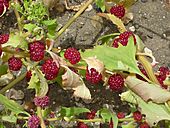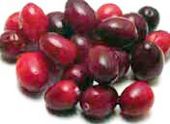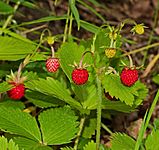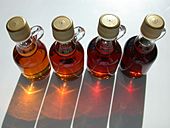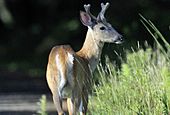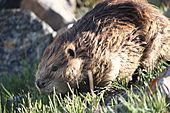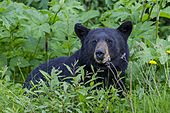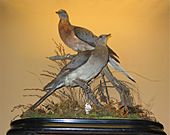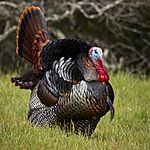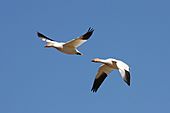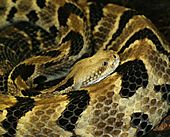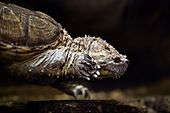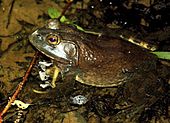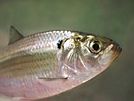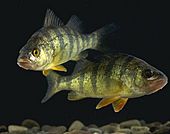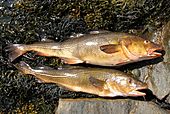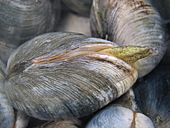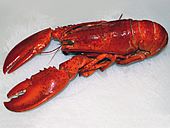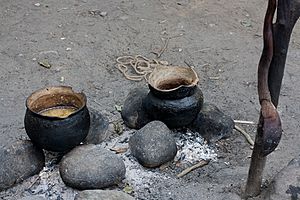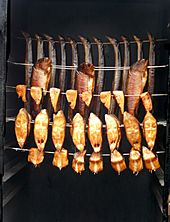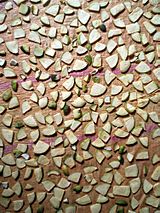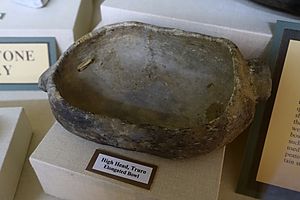Southern New England Algonquian cuisine facts for kids
The Native American people of Southern New England, like the Wampanoag and Narragansett, had a special way of cooking and eating. This way of life was shared by many Algonquian-speaking groups in places like Massachusetts, Connecticut, Rhode Island, and parts of New Hampshire and Long Island. They all spoke similar languages and had similar cultures.
Their food traditions changed with the seasons. New England has cold winters, so it was important to save food for when fresh food was hard to find. Their main foods were crops like corn, beans, and squash, often called the 'Three Sisters'. They also ate a lot of meat, fish, shellfish, and wild plants they found.
When English settlers arrived, they learned many cooking methods and dishes from the Native people. Foods like clam chowder, baked beans, and corn on the cob are still popular in New England today because of these Native influences. The Native people also started using some of the settlers' foods, and their cooking styles blended over time.
Contents
History
Hunting and Gathering Foods
Before farming became common, people got all their food by hunting, fishing, and gathering wild plants. The earliest people in New England, called Paleo-Indians, arrived around 13,000 BC. They hunted large animals like mastodons. As the climate changed and these big animals died out, people started hunting caribou, moose, and deer. They also gathered plants like marsh tubers and wild greens.
The climate warmed quickly during the Archaic Period. The land changed from cold grasslands to forests like we see today. Sea levels rose, changing the coastlines. By 7000 BC, many of the fish, birds, and plants found in New England today were already here.
The population grew during this time. People moved into the area, and there was more food available, especially oily nuts from trees. Hunters also got better at their craft. They started using a tool called an atlatl, which helped them throw spears with more power. They also made different stone points and hooks for hunting various animals. By the end of this period, people were gathering most of the wild foods that were still eaten when the first European settlers arrived, especially shellfish. Huge piles of shells, called middens, can still be found along the coast.
Even after farming began around 1000 BC, Native people continued to hunt, fish, and gather. These activities were still very important for their diet. Around 500 AD, they started using ceramic pots, which were lighter and heated food faster than stone pots. The bow and arrow, which appeared around 700 AD, made hunting much easier and quieter. In areas where farming was difficult, like rocky uplands or sandy shores, hunting and gathering were even more vital. These skills also helped people survive when crops failed or food was scarce in winter.
Starting to Farm
Farming began in eastern North America on its own. Crops and growing methods spread through trade. Early crops included starchy seeds like little barley and maygrass, and goosefoot, which is similar to quinoa. People also ate goosefoot and erect knotweed as leafy vegetables. Oils were taken from marsh elder and sunflower seeds, and the leftover meal was used in bread. Other crops included Jerusalem artichoke tubers and early types of squash, which were first grown for their gourds and edible seeds.
Around 500 AD, the 'Three Sisters' – corn, beans, and squash – arrived in New England from Central America. By 1100 AD, these crops had mostly replaced the older ones because they produced much more food per acre. However, it took time to develop varieties that could grow well in New England's colder climate. New types of squash with edible flesh, like the pumpkins we know today, also appeared. Even with farming, wild foods, fish, and shellfish were still important parts of the diet, especially for people living near the coast.
The idea of the Three Sisters spread with people moving from southern Ontario and western New York. This is supported by the spread of certain pottery styles into New England. Over time, the Native people of New England developed their own unique culture and languages, which were largely in place when Europeans first arrived.
Regional Variation
The Native people of Southern New England shared many cultural traits and related languages. Differences in their food mainly came from small changes in climate and what foods were available nearby. We know about these differences from old stories told by colonial settlers.
For example, the Pawtucket people in what is now northeastern Massachusetts and coastal New Hampshire did not eat bread. They preferred stewed corn kernels as a side dish. They also did not thicken their stews with grain and often mashed different slow-cooked meats together. The Massachusett and Nipmuc people, who lived west of them, did make bread. Their bread was often made with mashed beans or had a lot of boiled beans in it. The Narragansett people especially loved cornbread mixed with chestnut meal and fruits.
Generally, the region can be divided into four food areas: coastal, inland, upland, and island.
The uplands, with their rocky hills, had shorter growing seasons and less fertile soil. Hunting, fishing, and gathering were more important here. This area had plenty of maple syrup, which was less common along the warmer coast. It also had more furs and large animals like deer, moose, and bears, which were valued for their fat.
People in the interior lived around large lakes and rivers. These areas offered water, fertile land for farming, and fish. Waterfalls and river junctions were important meeting places during fish spawning runs, where many tribes gathered to catch fish. Like the uplands, interior regions were less populated than coastal areas, making hunting easier. They also had many lakes and rivers for fishing and gathering freshwater shellfish.
Coastal areas had more people, so they could not rely as much on hunting and gathering. The warmer climate allowed for a longer farming season, and the flat, fertile soils supported more farming. The most important resource was shellfish, which were safer and more plentiful than freshwater shellfish. Fish spawning runs were also very important, with coastal people getting the first pick of fish before they swam upstream. People also fished in the deep sea and hunted large marine mammals from dugout canoes. Coastal people did not produce much maple syrup because the ocean climate limited maple tree growth. Instead, they made 'Indian jams' and other preparations to flavor foods. People on islands relied even more on marine resources, as farming and hunting were limited.
Ingredients
Agriculture
The 'Three Sisters' – corn, beans, and various squashes – were the main foods and often eaten together. Native women also grew sunflowers for their oily seeds and Jerusalem artichokes for their starchy roots. It is thought that they also planted fruit and nut trees in cleared areas to provide food for the future.
Gathered Plants
In Native culture, women collected wild foods in addition to farming. They would go out several times a year to gather plants. The season was very important for what foods were available. Some plants were only edible in early spring, others in summer when berries ripened, or in fall when roots were big and fruits were ready. Foods were used as grain-like seeds, oily nuts and seeds, root vegetables, leafy greens, or sweet saps. Some plants could fit into more than one group.
Seeds
Many plants were valued for their plentiful, grain-like seeds. Fresh seeds were boiled in stews. Dried seeds were used for porridges or ground into flour. This flour was added to bread or used to thicken soups and stews. Some grains, like goosefoot and little barley, were once farmed but continued to be gathered from the wild. Beechnuts were small and used like grain seeds. Amaranth and chenopod seeds were similar to modern quinoa.
- Amaranthus blitoides, 'prostrate pigweed' (leaves also edible).
- Amaranthus hybridus, 'smooth pigweed' (leaves also edible).
- Celtis occidentalis, 'hackberry'.
- Chenopodium berlandieri, 'goosefoot' (formerly farmed).
- Comptonia peregrina, 'sweetfern'.
- Fagus grandifolia, 'beechnut'.
- Hordeum jubatum, 'foxtail barley'.
- Hordeum pusillum, 'little barley' (formerly farmed).
- Nuphar variegata, 'yellow pond-lily'.
- Phalaris caroliniana, 'maygrass' (formerly farmed).
- Zizania aquatica, 'wild rice'.
Oily Nuts and Seeds
Nuts and oily seeds were shelled, ground, and boiled to get their oils. The oil was stored for winter soups and stews, to baste roasting meats, or as a preservative. The protein-rich meal left over was added to breads or used to thicken soups.
- Carya glabra, 'pignut' (hickorynut).
- Carya laciniosa, 'kingnut' (hickorynut).
- Castanea dentata, 'chestnut'.
- Corylus americana, 'common hazelnut'.
- Helianthus annuus, 'sunflower' (usually farmed).
- Juglans cinerea, 'butternut'.
- Juglans nigra, 'black walnut'.
- Quercus sp., 'oaknut'/'acorn'.
Root Vegetables
Starchy roots, bulbs, and underground stems were valuable foods because they provided energy. If they were starchy enough, they could be ground into flour for bread. They were best eaten boiled in stews or roasted in ashes, much like potatoes are eaten today.
- Allium canadense, 'Canada onion' (eaten for tubers and as flavoring).
- Amphicarpaea bracteata, 'ground bean'.
- Apios americana, 'groundnut'.
- Argentina egedei, 'silverweed'.
- Lilium canadense, 'Canada lily'.
- Lilium superbum, 'Turk's cap lily'.
- Medeola virginiana, 'Indian cucumber'.
- Oenothera biennis, 'evening primrose'.
- Nymphaea odorata, 'white water-lily'.
- Sagittaria latifolia, 'duck potato'.
- Typha latifolia, 'cattail'.
Greens
-
Chenopodium capitatum or 'strawberry goosefoot.'
Leaves, shoots, and buds were usually gathered in spring when they were tender and less toxic. Seaweed was also dried or boiled in soups for flavor by coastal people.
- Allium tricoccum, 'ramp' (valued as a vegetable and for garlic-like flavor).
- Amaranthus sp. (leaves edible at all stages).
- Atriplex cristata, 'orache'.
- Asclepias sp. (young growth edible if cooked well).
- Caltha palustris, 'marsh marigold' (leaves edible before flowering, after boiling).
- Chenopodium sp., chenopods (leaves edible at all stages).
- Clintonia borealis, 'yellow bead-lily' (young leaves edible).
- Fiddlehead-stage of various ferns (edible after boiling).
- Ligusticum scothicum, 'Scots lovage' (young leaves and stems edible).
- Nyphaea odorata, 'water-lily' (young stems and leaves).
- Palmaria palmata, 'red dulce' (edible red algae).
- Phytolacca americana, 'pokeweed' (very poisonous; only very young leaves edible after much boiling).
- Rubus idaeus, 'red raspberry' (leaves edible after drying).
- Symplocarpus foetidus, 'skunk cabbage' (young leaves edible after drying and boiling).
- Tilia americana, basswood (first spring leaves and flowers edible).
- Typha latifolia, 'cattail' (young shoots and inner pith of stems).
- Ulva compressa, 'sea lettuce' (edible green algae).
Fruits and Berries
Sweet fruits ripened in summer and fall. They were eaten fresh, baked into breads for special occasions, or dried to flavor water. The seeds and pits of many fruits were also edible and ground into flour.
- Amelanchier sp., 'serviceberry'.
- Fragaria sp., 'strawberry'.
- Gaylussacia baccata, 'black huckleberry'.
- Morus rubra, 'red mulberry'.
- Prunus americana, 'wild plum'.
- Prunus maritima, 'sea plum'.
- Prunus serotina, 'wild cherry'.
- Rubus flagellaris, 'dewberry'.
- Rubus occidentalis, 'black raspberry'.
- Rubus odoratus, 'flowering raspberry'.
- Vaccinium sp. sect. Cyanococcus, 'blueberry'.
- Vaccinium sp. sect. Oxycoccus, 'cranberry'.
- Viburnum lentago, 'nannyberry'.
- Viburnum nudum, 'wild raisin'.
- Vitis sp., 'wild grape'.
Saps and Syrups
Native people taught European settlers how to tap maple trees for sap to make syrup and sugar. In coastal areas where maples didn't grow well, they used elderflower, nannyberries, sweetflag, and birches instead.
- Acer sp., 'maple' and 'box elder'.
- Acorus americanus, 'American sweetflag'.
- Betula alleghaniensis, 'yellow birch'.
- Betula lenta, 'black birch'.
- Tilia americana, 'elderflower' ('basswood tree').
- Viburnum sp., flowers and fruit could be boiled into syrup (only some types are edible).
Hunted Animals
In Native tradition, men were the hunters. They made bows, arrows, spears, hooks, and traps. The most prized animal was the white-tailed deer. Forests were sometimes cleared by controlled fires to create grassy areas where deer liked to feed. Men also gathered for annual deer hunts, using calls and drums to drive deer into ambushes.
Large mammals were valued for their meat, furs, skins for clothing, bones for tools, and sinews for bowstrings. Bears were especially prized for their fat. All edible parts of an animal were used, especially during times of food shortage.
Mammals
Smaller mammals were usually caught in snares and traps. Most large predators like wolves and mountain lions were left alone, possibly due to cultural beliefs. Coastal people hunted seals and whales, or harvested whales that washed ashore.
- Alces alces subsp. americana, 'eastern moose'.
- Castor canadensis, 'beaver'.
- Cervus canadensis subsp. canadensis (extinct), 'eastern elk'.
- Cetacea infraorder (excluding dolphins and porpoises), 'whale'.
- Didelphis virginiana, 'possum'.
- Erethizon dorsatum, 'porcupine'.
- Family Leporidae, 'rabbits and hares'.
- Marmota monax, 'woodchuck'.
- Mephitis mephitis, 'striped skunk'.
- Odocoileus virginianus, 'deer'.
- Ondatra zibethicus, 'muskrat'.
- Neovison macrodon (extinct), 'sea mink'.
- Family Phocidae, 'seals'.
- Procyon lotor, 'raccoon'.
- Ursus americanus, 'black bear'.
- Vulpes vulpes, 'red fox'.
Birds
Geese, turkeys, ducks, and swans were caught with nets or bows and arrows. Cormorants were caught while they slept. The extinct passenger pigeon was very important because their huge flocks allowed many to be caught during migration. Bright feathers were used for decoration. Large birds of prey, crows, and ravens were usually avoided. Eggs were sometimes gathered by women and added to soups.
- Agelaius phoeniceus, 'red-winged blackbird'.
- Aix sponsa, 'wood duck'.
- Anas platyrhynchos, 'mallard duck'.
- Anas rubripes, 'American black duck'.
- Ardea alba, 'great egret'.
- Anser caerulescens, 'snow goose'.
- Branta canadensis, 'Canada goose'.
- Colinus virginianus, 'northern bobwhite'.
- Ectopistes migratorius, 'passenger pigeon' (extinct).
- Egretta caerulea, 'little blue heron'.
- Meleagris gallopavo , 'wild turkey'.
- Mergus merganser, 'common merganser'.
- Phalacrocorax sp. 'cormorants'.
- Poecile atricapilla, 'black-capped chickadee'.
- Rallus limicola, 'Virginia rail'.
- Quiscalus quiscula, 'common grackle'.
- Spizella pusilla, 'field sparrow'.
- Tympanuchus cupido sub. cupido, 'heath hen' (extinct).
- Zenaida macroura, 'mourning dove'.
Reptiles and Amphibians
Various turtles and frogs added to the diet. Snake skins were used for belts and decorations. Turtle shells were made into jewelry.
- Chelydra serpentina, 'common snapping turtle'.
- Clemmys guttata, 'spotted turtle'.
- Chrysemys picta, 'painted turtle'.
- Crotalus horridus, 'timber rattlesnake'.
- Glyptemys insculpta, 'wood turtle'.
- Lithobates catesbeianus, 'American bullfrog'.
- Lithobates clamitans, 'American green frog'.
- Lithobates pipiens, 'northern leopard frog'.
- Nerodia sipedon, 'northern water snake'.
- Pantherophis obsoletus, 'black rat snake'.
Fished and Collected Foods
Fish
Men were the traditional fishermen. They made fishing spears, nets, traps, and hooks from bone, wood, and stone. The long coastline offered many fishing options. Deep-sea fish were caught with weighted lines. People also used 'pummee' (fish grease) to attract fish to the surface, similar to chumming, so they could be netted easily. 'To go wigwassing' was a term settlers used for night fishing with torches to attract eels, squid, and herring.
People gathered at waterfalls and rapids along rivers. The most important event was the annual spawning run of river herring, salmon, and eels. This attracted people from all over the region. Large fish-weirs, like the Boylston Street Fishweir, were built to guide fish into traps where they could be easily caught. People in freshwater areas also fished year-round in rivers, lakes, and ponds. Ice fishing was done in deep winter when other foods were scarce. Many fish species caught then are still important in New England today. Some local fish names, like 'chogset' and 'tautog,' come from Native languages.
Freshwater, Catadromous or Anadromous
- Alosa pseudoharengus, 'alewife'.
- Alosa aestivalis, 'blueback herring'.
- Anguilla rostrata, 'American eel'.
- Acipenser sp., 'sturgeon'.
- Brevoörtia tyrannus, 'Atlantic menhaden'.
- Dorosoma cepedianum, 'gizzard shad'.
- Esox americanus, 'American pickerel'.
- Microgadus tomcod, 'tomcod'.
- Morone saxatilis, 'striped bass'.
- Perca flavescens, 'yellow perch'.
- Salmo salar, 'Atlantic salmon'.
- Salvelinus fontinalis, 'brook trout'.
- Sander vitreus, 'walleye'.
Saltwater
- Breviraja nigriventralis, 'blackbelly skate'.
- Brosme brosme, 'cusk'.
- Calamus penna, 'sheepshead porgy'.
- Cetorhinus maximus, 'basking shark'.
- Clupea harengus, 'Atlantic herring'.
- Gadus morhua, 'Atlantic cod'.
- Hippoglossoides platessoides, 'American plaice'.
- Hippoglossus hippoglossus, 'Atlantic halibut'.
- Lopholatilus chamaeleonticeps, 'great northern tilefish'.
- Micropogonias undulatus, 'Atlantic croaker'.
- Pleuronectes putnami, 'smooth flounder'.
- Pomatomus saltatrix, 'bluefish'.
- Family Sparidae, 'porgy'.
- Stenotomus chrysops, 'scup,' 'scuppaug' or 'mischup'.
- Tautoga onitis, 'tautog'.
- Tautogolabrus adspersus, 'chogset'.
Shellfish
Mollusks like clams, snails, oysters, and scallops were dug from the sand at low tide or picked off rocks. This was another traditional activity for Native women along the coast. Men usually caught lobsters and crabs with nets and traps, but women would often catch those stranded in tide pools. Urchins and sea cucumbers were also sometimes gathered. Freshwater clams were eaten by inland people, but they were less common and sometimes unsafe. Most inland people traded for dried clams from coastal people.
- Argopecten irradians, 'bay scallop'.
- Crassostrea virginica, 'eastern oyster'.
- Elliptio complanata, 'eastern elliptio' (freshwater).
- Ensis leei, 'jackknife clam'.
- Homarus americanus, 'lobster'.
- Lampsilis radiata, 'eastern lampmussel' (freshwater).
- Ligumia nasuta, 'eastern pondmussel' (freshwater).
- Hyas araneus, 'great spider crab'.
- Mercenaria mercenaria, 'quahog'.
- Mya arenaria, 'soft-shell clam' (steamers).
- Mytilus edulis, 'blue mussel'.
- Procambarus acutus, 'white river crayfish' (freshwater).
- Quadrula quadrula, 'mapleleaf mussel'.
- Strongylocentrotus droebachiensis, 'green sea urchin'.
- Pandalus borealis, 'pink shrimp'.
Famine Foods
When food was scarce due to bad harvests, droughts, or long winters, Native people ate other foods. They would eat bark, young pine leaves, and certain types of lichens in winter or when traveling. In warmer seasons, they could dig up worms and grubs, catch smaller animals, and search a wider area for food. European settlers did not always understand how much Native people relied on gathering wild foods. This led to starvation for many Native people when their lands were taken or sold.
Cooking and Preservation Methods
Cooking
Soups, stews, and porridges were cooked in large clay pots. These pots were set upright with rocks around them, and a fire was built underneath. Less liquid was used for stewing corn and beans. Reed mats were used to keep the heat in. Since these clay pots were heavy and could break, they were not moved often. Homes were always built near fresh water. When traveling, people used lightweight, waterproof birch bark vessels over the fire. An older method involved heating stones in a fire until they glowed, then adding them to pots to heat the food. This method was less common when the English arrived. Native people later traded for copper and brass kettles from the English, which were lighter and heated faster.
Meat and fish were sometimes quickly roasted over flames to sear them. More often, food was cooked slowly over embers. Chunks of meat or whole birds and fish were put on stakes over the heat, or hung from frames made of sticks. To flavor the meat and keep it moist, oils and animal fats were used for basting. Aromatic bark and herbs were added to the fire for subtle smoky flavors. While some fresh game, fish, or shellfish might be eaten raw or lightly cooked, most foods were cooked thoroughly, except for some fresh greens and fruits. Fish were also cooked on wooden planks over hot stones.
Bread was baked in several ways. If large leaves like cornhusks or lily pads were available, unleavened dough made from cornmeal was wrapped in them and placed in hot ashes. It could also be baked directly in the ashes. Dough could be placed in greased cooking pots on hot stones or on wooden planks over hot ashes. For large gatherings, earth ovens were built. These were deep pits filled with hot stones, then covered with damp leaves or seaweed and earth. This traditional method inspired the New England clam bake tradition. Earth ovens were also used for root vegetables, fish, meats, and other foods. Because they took a lot of work, they were used for big events. Shellfish, fish, and meat were often baked simply on hot stones. Over time, ovens and metal cooking dishes replaced these older methods.
Frying was not a common cooking method for early English settlers, but they introduced it. Sometimes, foods like the ancestor of the Johnnycake were cooked in a lot of grease until lightly browned. However, deep-frying and pan-frying were not traditional Native cooking techniques.
Preservation
Long winters meant food was scarce, so Native women spent a lot of time preserving food. Beans were shelled, and pumpkins, squash, and fruits were sliced thin and dried in the sun. Corn was dried on the cob, shelled, or parboiled and then dried and ground into meal. Fish were splayed open, and lean cuts of meat were also dried. Some plants, like raspberry leaves and skunk cabbage leaves, were only edible after drying. Many medicinal plants also needed to be dried. Storage pits, lined with stones and reed mats, were filled with bags of corn and baskets of food, then sealed with mats and earth.
Thin strips of lean meat and small fish were dried. Fattier meats, oily fish, and shellfish like lobsters, crabs, clams, and snails had to be smoked because they would spoil even if dried. When a lot of food needed to be preserved, a smoking hut, like a wigwam without ventilation, was built. This was especially done during fish spawning runs and large shellfish harvests in the autumn. Dried sassafras and hickory bark were prized for their smoky flavor and for helping preserve the food. Sometimes, dried herbs were added to the fire for extra flavor.
Fruit was also boiled down to make syrups or 'Indian jams' for sweeteners, flavorings, or medicine. Sometimes, this was done by simply boiling chopped fruit with water. To speed it up, fruit was cooked in syrups made from sweet flowers or tree saps, like maple syrup from cooler upland areas or birch syrup. Native people did not traditionally eat foods as sweet as the English colonists. However, through the English, Native cooks started using molasses, honey, and sugar, and began making fruits and jellies in new ways.
Salt-curing and fermentation were unknown to Native people before the Europeans arrived. Initially, Native people did not like the salty foods of the colonists. By the mid-1700s, with changing tastes and learning about animal farming from the English, Native people began to make cured meats similar to their new neighbors, but this was a slow process.
Dining Habits and Eating Customs
The Native people of Southern New England were known for being very generous and welcoming. Guests were always offered water and shared whatever food was available. Families often worked together, with men providing meat and fish, and women gathering, farming, and preparing meals. This was because preparing thick stews and breads, which were common meals, took a lot of effort and time.
Meals were not structured like the English colonists' three meals a day. Native people ate a lot when food was plentiful, sometimes described as 'gluttons' by the English. But during hard times, wars, hunting trips, or travels between camps, Native people might go days without a full meal. They would survive on dried squash slices and a little parched cornmeal, along with anything they could find along the way, just enough to stop hunger.
Women did all the food preparation and serving. Chiefs, elders, and guests were served first as a sign of respect. In Native households, women were treated more equally and were not excluded from eating with men. They could also join in mealtime conversations. English colonial women were often kept separate from formal dinners and ate with the children.
Foods were served when they were ready. Soups and corn gruel were served in carved wooden or clay bowls and eaten with wooden or shell spoons. Dryer foods were placed in wooden or clay dishes, baskets, or on reed mats. Meals were eaten on reed mats on the ground, or on benches built inside homes. English colonial homes also ate in a similar way, as forks and other utensils were expensive and hard to get.
Dishes
Beverages
Water was the most common drink, served hot or cold from gourds or bowls. Native settlements were always near a fresh water source. In cold weather, water was heated, or soups were made thin to provide warmth and hydration.
Fruit, squash, and corn juices were sometimes consumed. After plain water, flavored waters were the next most common drinks. Water was simply flavored with blossoms, fruit, syrups, or herbs, often served hot like a tea.
- Elderflower tea: water boiled with elderflowers, served hot or cold.
- Indian lemonade: water flavored with sumac berries and sweetened with syrup.
- Nannyberry syrup tea: water flavored with nannyberry syrup from blossoms or berries.
- Oswego tea: water flavored with bee balm leaves and flowers, served hot or cold.
- Raspberry leaf tea: water boiled with dried raspberry leaves.
- Strawberry tea: water flavored with dried strawberries, served hot or cold.
- Strawberry leaf tea: water boiled with fresh or dried strawberry leaves.
- Walnut milk with squash: hot water mixed with powdered walnut and mashed squash, used as a substitute for breastmilk.
- Chestnut milk: similar to walnut milk, but made from chestnut, also served with mashed squash.
- Maple sugar drink: water sweetened and flavored with maple sugar.
- Fox grape juice: pressed juice of fox grapes, watered down.
- Sassafras root tea: water boiled with sassafras roots, used for medicine.
- Green corn drink: sweet corn mashed and pressed for its juice, then mixed with water.
Images for kids
-
Strawberry leaf tea, made from fresh Fragaria vesca leaves.
-
Oswego tea steeping, made from fresh Monarda didyma leaves.


